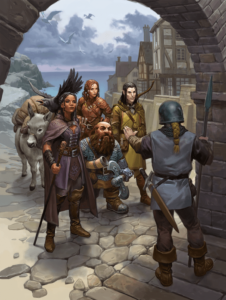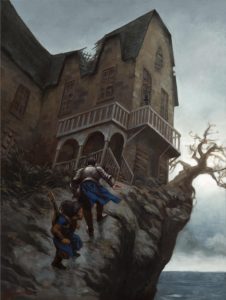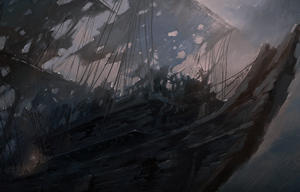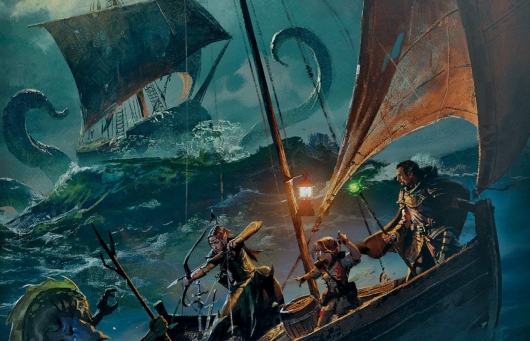RPG Review: Ghosts of Saltmarsh
Ghosts of Saltmarsh is the brand new book from Wizards of the Coast, broken down into three parts. Firstly, it’s a supplement about the village of Saltmarsh. The book recreates seven classic adventures for 5th edition and tying them together, as well as a supplement exploring ships and the sea. Whether or not you’re going to play in these adventures, there’s a ton here for any seagoing campaign, with some interesting locations to drop into your campaign.
Saltmarsh
 Saltmarsh is firmly set in Greyhawk, as it was in the previous adventures, so this is our first journey into Gary Gygax’s setting for 5e. Set on the coast of the kingdom of Keoland, Saltmarsh is a town in development, as the kingdom seeks to expand its port to increase their power along the southern coast. Three factions, The Traditionalists, the Loyalists, and the Scarlet Brotherhood all vie for control. The Traditionalists don’t want the town under the heel of the capital, Loyalists welcome the opportunity for new developments, and the Scarlet Brotherhood works secretly to undermine not only Saltmarsh and Keoland, but all of Oerth.
Saltmarsh is firmly set in Greyhawk, as it was in the previous adventures, so this is our first journey into Gary Gygax’s setting for 5e. Set on the coast of the kingdom of Keoland, Saltmarsh is a town in development, as the kingdom seeks to expand its port to increase their power along the southern coast. Three factions, The Traditionalists, the Loyalists, and the Scarlet Brotherhood all vie for control. The Traditionalists don’t want the town under the heel of the capital, Loyalists welcome the opportunity for new developments, and the Scarlet Brotherhood works secretly to undermine not only Saltmarsh and Keoland, but all of Oerth.
Saltmarsh is a town of around 5000, mostly human, with a few elves, halflings and dwarves. This section of the book features a map of the town, along with 30 different locations. Nearly every single one has something the players can do that could be spun off into its own adventure. Mafera, a human blacksmith, for example, runs a dwarven blacksmith, which sets the local dwarves on edge, wondering how she came by the forge. Perhaps the PCs could be hired to investigate. Elsewhere, at Hoolwatch Tower, a d6 table tells you what jobs are available for the PCs to take on. A tiefling captain has magical goods for sale, but there’s a spoilery twist. The town feels very lived in, ready for the players to take up permanent residence. The book takes time to provide ideas for downtime activities.
There is detail on the region around Saltmarsh as well, such as the outpost of Burle, the dwarven mine, or the Dreadwood, an evil and cursed forest nearby. There’s a nice overland map printed in white and blue like the 1e maps of old, but much better quality. There are many random encounters, and some really great details to further your own adventures in the region.
Not only that, but Backgrounds get a big look here, seeing how they can be used most effectively to tie characters into the region, as well as presenting some new options such as the Fisher, Smuggler, and the Shipwright.
The Adventures
 Each adventure is drawn from previous adventures seen throughout the history of D&D, laid out to connect them together not necessarily creating an overall coherent story. Saltmarsh itself has enough content to link them together.
Each adventure is drawn from previous adventures seen throughout the history of D&D, laid out to connect them together not necessarily creating an overall coherent story. Saltmarsh itself has enough content to link them together.
The Sinister Secret of Saltmarsh was initially released in 1981 through TSR’s UK branch, and has the heroes venturing into a decrepit manor that the villagers say is haunted. I don’t want to spoil too much of the adventure, as there’s a good twist, but the map is really simple and straightforward. I imagine lots of 3d printing folks will be creating the manor like they have with Trollskull Tavern from Dragon Heist. One piece of art stood out in particular here: The Skeletal alchemist, with his glowing, whispy beard, is really beautiful work. The adventure has a lot of great locations, and focuses on exploration rather than combat, though combat is absolutely an option. The house itself is good and creepy, and you can definitely do a lot to set the mood there. The second half of the adventure takes you aboard a pirate ship, which begins to tie you into the seafaring rules in the back of the book. The players can acquire a ship by the end of the adventure to help in further adventures.
Danger at Dunwater takes you into the jaws of a Lizardfolk colony based on information you glean from the previous adventure. The adventure was also from the same era as Sinister Secret and was designed at the time as a direct sequel. The players must win the lizardfolk’s trust. There’s a series of actions the players can take that will immediately turn the lizardfolk against them, and some suggestions for how to roleplay lizardfolk. There’s an extensive table laying out every member of the lair and where they start out, so there’s a lot to keep track of, especially as conditions change in the adventure.

Salvage Operation has the heroes venturing aboard a ruined ship, once lost at sea, now found adrift. It’s a dungeon crawl in an incredibly confined space, along with a battle against a massive octopus. The adventure originally appeared in Dungeon 123, for 3rd edition. The whole lower deck of the ship is covered in thick webbing with giant wolf spiders and an ettercap taking up residence. When I spoke about the giant octopus earlier, I mean it’s GIANT. It’s capable of tearing the ship apart, with the players mostly aiming to drive the thing off. The adventure gives a round-by-round breakdown of what happens once the cephalopod shows up.
Isle of the Abbey is based on the adventure from Dungeon 34, where the players travel to an island just off-shore. The local mariners’ guild wants to build a lighthouse on the island, but needs it cleared off first. Knowing it’s rumored to have previously been owned by a cabal of evil clerics, the heroes are payed a hefty sum to fix their little issue. My favorite part of the adventure is at the very beginning. The island juts up from the water, cliffs on all sides, except from a sandy beach to the south. The area is full of buried skeletons, who rise up to defend the island like a minefield, requiring the players to very carefully navigate their way through the area. Each square of the dunes is 150 feet, and has a certain number of skeletons inhabiting it who will rise up. There’s a very specific way you can venture through the area to avoid a skeleton attack. Once you’ve made your way to the abbey, the basement is a pretty old-school dungeon crawl. Trip wires, pit traps, false rooms, treasure. It feels very old-school, but in a classically zany entertaining way.
The Final Enemy comes from the third part of the Saltmarsh trilogy found in Sinister Secret and Danger at Dunwater, from 1983. While the first level of the Sahaugin fortress is above water, the lower levels are completely submerged, requiring the players to find the magical items needed to breath underwater for the remainder of the adventure. Tension can be ratcheted up as their potions of water breathing begin to wear off, and the players will likely encounter creatures they never have before, such as shell sharks and the Maw of Sekolah, a two-headed shark avatar of the Sahuagin god. The adventure then moves into a military battle as the forces of Saltmarsh move to attack the Sahuagin lair. I like the rules here, as they give out victory points based on certain conditions, to help determine how successful the attack was.
Tammeraut’s Fate, based on the 3e adventure from Dungeon 106, has the PCs trying to find out who slaughtered the residents of Firewatch Island. The adventure consists of an extensive fortress exploration session before the true scope of the adventure is realized. It leads to a large battle against undead forces, and has a lot of places the adventure can branch out to afterward, beyond the scope of the book.
The Styes is a murder mystery based on an adventure from 2005 in Dungeon 121. The whole thing is deeply Lovecraftian, set in a rundown town that is slowly being reclaimed by the sea. I don’t want to reveal too much about this, save that with the right mood, this can be a very dark and creepy story.
Ships, Ships, Ships
After all the adventures, the book fleshes out ships and seafaring. It explains the statblock for a ship, which looks similar to a monster statblock, with a lot of exceptions. Each part of the ship has a certain number of Hit Points, meaning that you can target certain parts of an enemy’s ship to effect the course of a battle. The rules allow for a sort of plug-and-play, with characters being assigned to operate parts of the ship during seagoing adventures and battles.
Each example ship has a certain number of required crewmen, which almost immediately gives you a ton of roleplaying opportunities. The book also has a bunch of ship upgrades, such as ever-full sails, concussive rounds, and even magical ship figureheads.
There are rules for crew conflict, fire, fog, and many other hazards. This is a pretty extensive set of rules for seagoing adventures, which we haven’t seen since 3e’s Stormwrack. This section also has some amazing tables of story hooks and different things you may find on various types of islands. Pull out your old Pirates of the Spanish Main minis, because you’re going to need them here.
This is SUCH a fantastic book. If you’re planning on venturing ANYWHERE NEAR the sea, you should pick up this book. Most other adventures for 5e take place on the Sword Coast, so it’s worth picking up to slip some seafaring stuff into those. Have your players head to Chult for Tomb of Annihilation by ship and have some adventures along the way. Have your players take a ship up the coast rather than a caravan in Horde of the Dragon Queen. Take to the Darklake in the Underdark in Out of the Abyss. The possibilities are endless.
I really love this book. It’ll be getting utilized more than any other adventure book, simply because it’s useful in so many other contexts. I highly recommend it.
Wizards of the Coast provided a copy of Ghosts of Saltmarsh to Dice Monkey for review.
Support Dice Monkey with a single payment on Ko-Fi, or become a Dice Monkey Patron. Thank you for your support!

